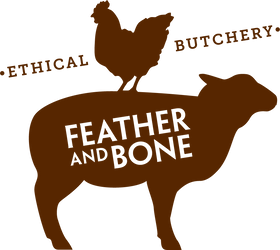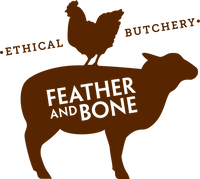The Miracle of the Ruminant (musings on veal)
First published in the Feather and Bone newsletter, 26 November 2012.
The veal we sell is a different product from what is commonly sold as veal. None of the farms that supply Feather and Bone are commercial dairy farms where the unwanted male calves (or bobby calves) are sold at less than one week of age! Nor is it 10 - 12 month old yearling beef either.
Between these two extremes lies what Tony Franckin from Comboyne, a first-gen Australian from northern Italy, likes to call ‘vitellone’. There are various definitions one may find for the word but think, ‘large veal’, but not too large. At between five-eight months what you get is both tenderness and flavour.
The calves are still with their mothers but are also successfully grazing the diverse pastures on which they live. This last point is the key. The ideal age for us to source our veal is at around six months. It’s at this point that the calf will have learnt to perform, on a daily basis, ‘the miracle of the ruminant’.
From being born a mono-gastric (single-stomach) animal, like you, me and the dog, the calf is now a fully fledged ruminant (one stomach, four chambers), able to convert tall grasses to a single mound, albeit with an abiding taste for mother’s milk! Of course the cow understands that the calf has achieved this glorious state of rumination(!) and is, despite continuing visits to the teat, able to look after itself. As a result, weaning is a far less traumatic event at this age than say, a couple of months earlier.
A couple of years ago we ignorantly thought that the veal bodies we were sourcing from South Hill farm should be a little smaller, that is, younger, and a couple were supplied at this smaller size. I say ignorantly because we didn’t understand the range of factors that would bear on what we thought was a simple preference.
The cows that had surrendered their calves prematurely the year before were highly agitated when yarded with their calves at the same age, the following year. Please understand these cows are rotationally grazed and are moved daily onto fresh pasture and are uncommonly relaxed and accepting of Clara - their farmer - in any situation. Even allowing her to handle their young for tagging from the day they’re born.
It's my guess that the level of a cow’s anxiety following separation is directly proportionate to the development of the rumen and the ability of the calf to get along without her very well. That trust quickly evaporates when a too-young calf (with an under-developed rumen) is taken, and the memory of that betrayal is tucked away for the following year.
Needless to say we quickly reverted to previous practice, and now only source slightly older and heavier calves.
It still astonishes me that a creature with the heft and majesty of a fully mature cow (or moose, or elk, or water buffalo) may be understood as a synthesis and distillation of every thing that is good in the simple pasture and forage that it is offered.
Which is, of course, why the raw materials the ruminant uses in this casual trans-substantiation must be of the of the highest quality, free from contamination, and rippling and bubbling with all of the life-giving force that good soil may hold, and pass on to the plants that it sustains.




Leave a comment